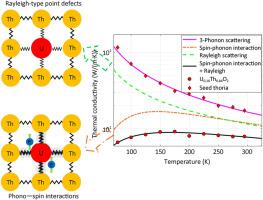当前位置:
X-MOL 学术
›
J. Materiomics
›
论文详情
Our official English website, www.x-mol.net, welcomes your feedback! (Note: you will need to create a separate account there.)
Thermal conductivity suppression in uranium-doped thorium dioxide due to phonon-spin interactions
Journal of Materiomics ( IF 9.4 ) Pub Date : 2023-12-05 , DOI: 10.1016/j.jmat.2023.11.007 Zilong Hua , Saqeeb Adnan , Amey R. Khanolkar , Karl Rickert , David B. Turner , Timothy A. Prusnick , J. Matthew Mann , David H. Hurley , Marat Khafizov , Cody A. Dennett
Journal of Materiomics ( IF 9.4 ) Pub Date : 2023-12-05 , DOI: 10.1016/j.jmat.2023.11.007 Zilong Hua , Saqeeb Adnan , Amey R. Khanolkar , Karl Rickert , David B. Turner , Timothy A. Prusnick , J. Matthew Mann , David H. Hurley , Marat Khafizov , Cody A. Dennett

|
In this work, impact of low level of uranium (U) atom substitution on thermal conductivity of thorium dioxide (ThO) is investigated. ThO is an electronic insulator with a wide optical band-gap and no unpaired electrons whose thermal transport is governed by phonons. U-substitution introduces unpaired -electrons resulting in paramagnetic behavior of UThO at room temperature, which significantly suppresses its thermal conductivity. A single crystal of UThO with graded composition of U is grown using a hydrothermal synthesis method, and thermal conductivity measurements are performed in regions with uniform composition of U at levels of 0%, 6%, 9% and 16%. Measured thermal conductivity profiles over 77–300 K temperature range are analyzed using an analytical expression for phonon-mediated thermal transport based on Klemens-Callaway model. Temperature dependent thermal conductivity is found to deviate significantly from the Rayleigh scattering trend expected for a simple substitutional point defect with a small perturbation to mass and interatomic forces. With the resonant scattering term, observed large suppression of thermal conductivity at low temperatures can be closely reproduced. Additionally, the extracted phonon-spin coupling constants imply a nonlinear relation of phonon-spin interaction intensity with respect to U doping percentage. Our study reveals how phonon-spin scattering contributed by unpaired -electrons in U atoms influences thermal transport in the UThO system.
中文翻译:

由于声子自旋相互作用而抑制掺铀二氧化钍的热导率
在这项工作中,研究了低水平的铀(U)原子取代对二氧化钍(ThO)热导率的影响。 ThO是一种具有宽光学带隙的电子绝缘体,没有不成对的电子,其热传输由声子控制。 U-取代引入了不成对的 电子,导致 UThO 在室温下具有顺磁行为,从而显着抑制其热导率。采用水热合成法生长了具有梯度 U 成分的 UThO 单晶,并在 U 成分均匀(0%、6%、9% 和 16%)的区域进行热导率测量。使用基于 Klemens-Callaway 模型的声子介导热传输的解析表达式对 77–300 K 温度范围内测得的热导率曲线进行分析。发现与温度相关的热导率显着偏离对于质量和原子间力具有小扰动的简单替代点缺陷所预期的瑞利散射趋势。利用共振散射项,可以精确地再现观察到的低温下热导率的大幅抑制。此外,提取的声子-自旋耦合常数意味着声子-自旋相互作用强度与U掺杂百分比的非线性关系。我们的研究揭示了 U 原子中不成对电子造成的声子自旋散射如何影响 UThO 系统中的热传输。
更新日期:2023-12-05
中文翻译:

由于声子自旋相互作用而抑制掺铀二氧化钍的热导率
在这项工作中,研究了低水平的铀(U)原子取代对二氧化钍(ThO)热导率的影响。 ThO是一种具有宽光学带隙的电子绝缘体,没有不成对的电子,其热传输由声子控制。 U-取代引入了不成对的 电子,导致 UThO 在室温下具有顺磁行为,从而显着抑制其热导率。采用水热合成法生长了具有梯度 U 成分的 UThO 单晶,并在 U 成分均匀(0%、6%、9% 和 16%)的区域进行热导率测量。使用基于 Klemens-Callaway 模型的声子介导热传输的解析表达式对 77–300 K 温度范围内测得的热导率曲线进行分析。发现与温度相关的热导率显着偏离对于质量和原子间力具有小扰动的简单替代点缺陷所预期的瑞利散射趋势。利用共振散射项,可以精确地再现观察到的低温下热导率的大幅抑制。此外,提取的声子-自旋耦合常数意味着声子-自旋相互作用强度与U掺杂百分比的非线性关系。我们的研究揭示了 U 原子中不成对电子造成的声子自旋散射如何影响 UThO 系统中的热传输。
































 京公网安备 11010802027423号
京公网安备 11010802027423号